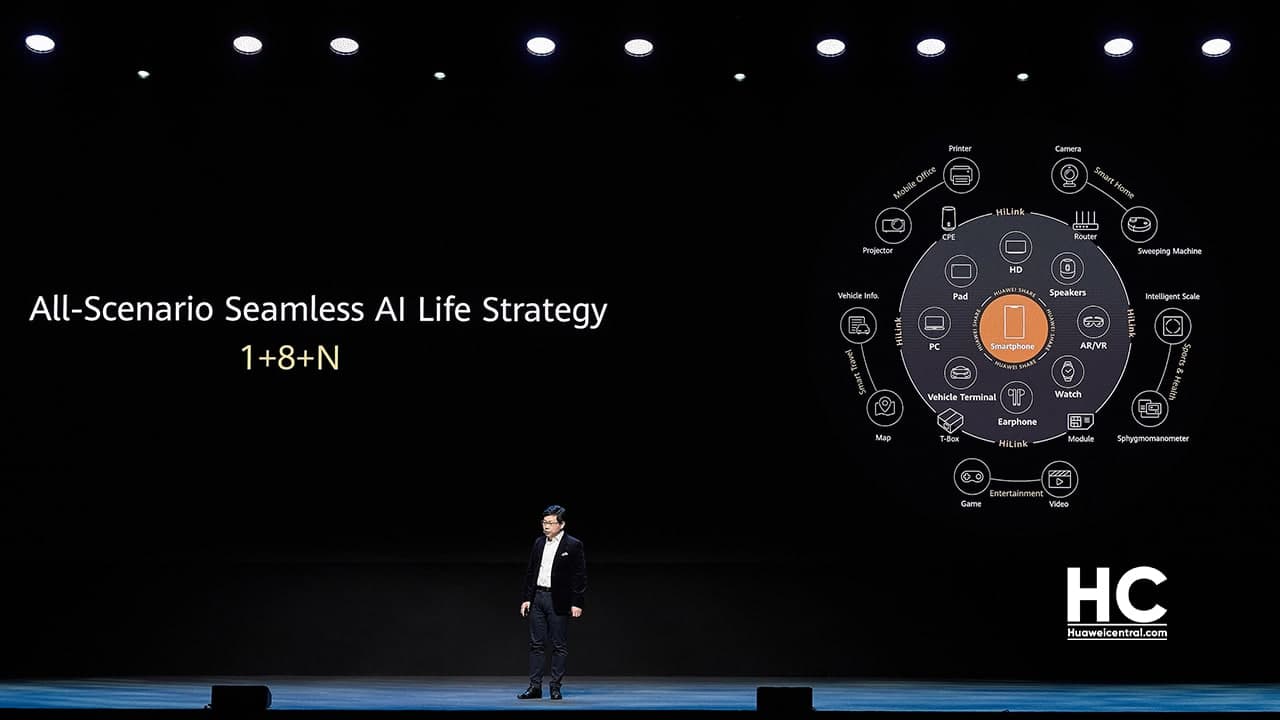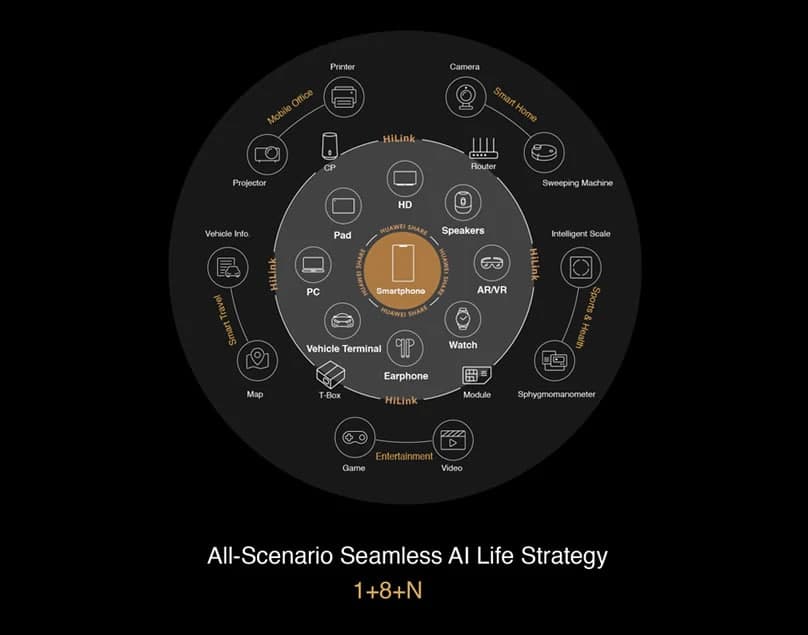Technology
Huawei 1+8+N Strategy: Smartphones, Smart Devices and Smart Ecosystem

Huawei‘s strategy for the Seamless AI Life experience is based on the innovative “1+8+N” product and software ecosystem which helps users stay connected effortlessly and at all times. With the newly announced range of IoT ecosystem partners and AppGallery applications, the company is committed to making life more seamless and intelligently connected for consumers.
According to Huawei, the company promises to create a world where everything works together seamlessly, intelligently, and effortlessly. While the era of 5G network is increasing, the user of IoT devices is also growing that’s why Huawei has doubled down on its plan to add value for consumers through the unique benefits of the 1+8+N ecosystem. Following this dedication, Huawei will expand its product focus areas such as audio, wearables, PCs, tablets, and other categories of connected technology.
Huawei’s 1+8+N strategy is based on a concept to deliver digital to every home, person, and organization to create a fully connected intelligent world. This ecosystem brings a collection of new technologies that work together to deliver the world’s most exciting new intelligently connected digital experience which can be controlled by the smartphone and connected by EMUI.
The Chinese tech giant has also explained its “1+8+N” strategy. The ‘1’ represents the smartphone, which is central to the ecosystem, connecting and controlling the broader devices.
In the ‘8’, the company has put external/peripheral connected devices such as Huawei FreeBuds, Huawei MatePad Pro, Huawei MateBook X Pro, Huawei Vision, Huawei Watch GT 2, Sound X, and Huawei FreeBuds. Its ‘N’ layer consists of all the third-party IoT devices which can be connected using Huawei HiLink and Huawei Share technologies.

However, Huawei is one of two device companies in the industry to have built its own software and hardware ecosystems, also it’s a brand that has unrivaled expertise in building networking infrastructure. These things make us believe that Huawei can bring unique benefits to consumers through distributed technology inside 1+8+N architecture.
New apps and partnerships announced as Huawei expands the ecosystem:
Huawei has several partnerships as it continually expands the 1+8+N ecosystem with new additions every week. Meanwhile, the company has continuously demonstrated its collaborative nature, often working with leading brands such as Leica and Devialet to enhance the customer experience.
Some of the examples are listed below.
- 360 Robot Vacuum Cleaner has been added to the 1+8+N ecosystem, providing an intelligent and automated floor cleaner that can be remotely controlled and monitored using the Huawei AI Life app on a Huawei device.
- Samsonite the world’s leading luggage brand has also entered into a partnership with Huawei. Moving beyond the home to offer connected benefits while traveling, 1+8+N users can simply tap their Huawei device on the Samsonite smart lock to lock their suitcase. Leveraging Huawei Share and Huawei Pay technology to make life easier and more secure when on the move.
- Joyoung Intelligent Thermostatic Electric Kettle has been added to the 1+8+N ecosystem, allowing users to remotely control and monitor their kettle using the Huawei AI Life app on a Huawei device. Making a cup of tea or coffee has never been easier.
- Kärcheris the world’s leading provider of cleaning technology. The brand is renowned for bringing innovative cleaning solutions to the market, the latest of which is the Huawei HiLink Kärcher Water Purifier. Now also added to the 1+8+N ecosystem, users can detect their water purifier’s filter life and water quality in real-time using the Huawei AI Life app on a Huawei device.
- OPPLE Lightingprovide a range of lighting solutions, including smart lighting. Integrating seamlessly into the 1+8+N ecosystem, users can now control their OPPLE smart lamps using the Huawei AI Life app on a Huawei device.
In addition to the exciting new hardware partnerships, Huawei has also added a range of popular apps to the Huawei AppGallery. Including a complete range of apps across several important verticals, this represents a significant step forward for Huawei and is set to delight users of the latest smartphones and tablets. Some of the most recent additions are set to capture users’ imaginations, and more new apps are being added every day.
- Social media: Telegram and Viber cater to users’ instant messaging and VOIP needs while TikTok is the top destination for short-form videos.
- Education: BBC Learning English, ClasseViva, and Kahoot! represent a wide spectrum of educational apps.
- Finance: Two of Spain’s largest banks, Caixa Bank and Santander add to the likes of BoC Pay, DBS Digibank, Eurobank, and Société Générale to offer essential banking and financial services for users.
- Gaming: Asphalt 9, Clash of Kings, Game of Thrones, Rise of Kingdoms join a growing list of games to keep users entertained at all times.
- Shopping: Lidl, JD Sports, AlliExpress, and Rakuten join a growing list of international vendors.
- Sports, Media, and Entertainment: The Sun and The Times to offer a well-rounded media and entertainment experience, with the Premier League and talkSPORT apps catering for sports fans.
- Travel and Accommodation: Booking.com, Skyscanner, and Agoda are joined by Emirates, Lufthansa, Turkish Airlines and more to provide all the tools users need to plan international trips, with Bolt, the popular ride-hailing service, helping people get around town easily.
- Maps, Navigation, and Search: Qwant search, HereWeGo maps, and Sygic navigation provide useful and secure tools to help users navigate the internet and the real world around them.
- Photo editing: Cut Cut, PicsArt, and PhotoGrid provide a rich suite of tools for photo editing, adding to Huawei devices’ already-exceptional photographic capabilities.
“Huawei has won the hearts of consumers around the world with our innovative and often ground-breaking technology. Now we are bringing this technology together for everyone via our 1+8+N ecosystem of products and software. Thanks to our Seamless AI Life experience, users can simply tap to connect most effortlessly, opening up a world of possibilities through Huawei Share, multi-screen collaboration, and more. By providing a Seamless AI Life experience for consumers everywhere, we hope to bring the world together and help people stay connected.” – said Andrew Garrihy, Global Chief Brand Officer of Huawei’s Consumer Business Group.
| Source – Huawei |








